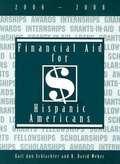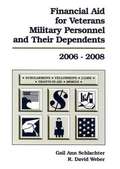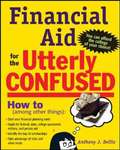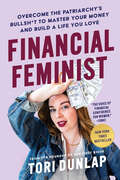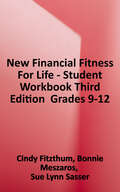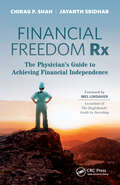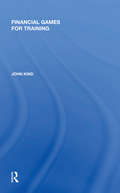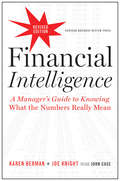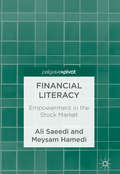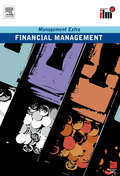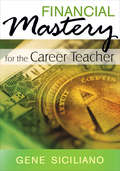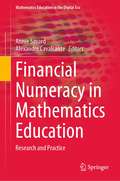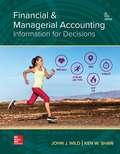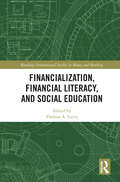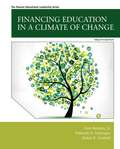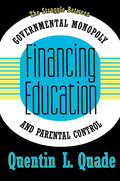- Table View
- List View
Financial Administration, M.A. Previous Public Administration paper-IV, SDE AU
by Dr Smt. L. Krishna Veni Prof.P.Krishna Prasad D. Venkateswara RaoThis is the prescribed textbook to the students of MA Previous Public Administration Paper-IV for the subject Financial Administration, at School of Distance education, Andhra University
Financial Aid for Hispanic Americans 2006-2008
by R. David Weber Gail Ann SchlachterA List of Scholarships, Fellowships, Loans, Grants, Awards, and Internships Open Primarily or Exclusively to Hispanic Americans and a Set of Six Indexes (Program Title, Sponsoring Organizations, Residency, Tenability, Subject, and Deadline Date)
Financial Aid for Veterans, Military Personnel and Their Dependents 2006-2008
by R. David Weber Gail Ann SchlachterVeterans, military personnel, and their dependents make up more than one third of America's population. Each year, public and private agencies set aside billions of dollars in financial aid for these groups (including the spouses, children, grandchildren, and dependent parents, and siblings of veterans and military personnel). If you have ties to the military, Financial Aid for Veterans, Military Personnel, and Their Dependents is the right book for you.
Financial Aid for the Disabled and Their Families 2006-2008
by R. David Weber Gail Ann SchlachterBillions of dollars in financial aid have been set aside for America's largest minority: the more than 50 million Americans with disabilities and members of their families. In fact, more money is available today than ever before! This funding is open to applicants at any level (high school through postdoctorate and professional) for study, research, travel, training, career development, assistive technology, specially-adapted housing, tax relief, and many other purposes.
Financial Aid for the Utterly Confused
by Anthony J. BelliaYes, you can afford a top-notch college education! You'll want to leave no stone unturned when it comes to paying for a great college education, so get the guide that answers all your questions! Written by a top financial aid pro with 30 years' experience, Financial Aid for the Utterly Confused clues you in on all your financing aid options. And it walks you through the entire process of obtaining the maximum amount to which you may be entitled. You get: Expert guidance on applying for all forms of financial aid; Insider tips on government and private financing, grants, and more; Proven cost-cutting strategies; Sample forms and worksheets; Early financial planning strategies for parents.
Financial Basics: A Money-Management Guide for Students
by Susan Knox<p>Jason is typical of today's college students, who are assuming unprecedented debt burdens because of relaxed limits on student loans and easily obtained credit cards. Many on college campuses are calling it a fiscal crisis. <p><i>Financial Basics</i> tackles the gaps in the personal financial knowledge of college students. Beginning with debit-credit card issues, student loan decisions, and the challenge of managing and reducing debt, Knox walks readers through money management. She skillfully addresses the how-to's of checking accounts, spending plans, emergency funds, and credit histories. She discusses financial personalities and the emotions of money, as well as practical record-keeping and simple filing techniques. <p>In <i>Financial Basics</i>, Knox blends her extensive money-management experience with her desire to inform and help students master their finances: she shares experiences about money lessons learned in college, and offers sound solutions and advice for students and their families. Since everyone does not handle money in the same way, Knox gives money-management options for readers to find their best way. The book includes helpful worksheets and is written in an easy-to-read style, using testimonials and examples that will ring true to students.</p>
Financial Feminist: Overcome the Patriarchy's Bullsh*t to Master Your Money and Build a Life You Love
by Tori DunlapFinancial Feminist has descriptive copy which is not yet available from the Publisher.
Financial Fitness for Life Student Workbook, Grades 9-12
by Bonnie Meszaros Scott Bacon Gail Colbert Cindy Fitzthum Sue Lynn SasserThis book is a CEE publication that helps teachers prepare students for life beyond the classroom by presenting materials based on real-world concepts in a way that reinforces learning through practice. The lesson plans within this collection have a description of the lesson, slides, and/or activities with educational technology tools such as Kahoot! and/or Quizlet. For full access to the book, shop for the Teacher Guide and Student Workbook.
Financial Freedom Rx: The Physician’s Guide to Achieving Financial Independence
by Chirag Shah Jayanth Sridhar"The best physician-specific general financial book published in 2021." —James M. Dahle, MD, author of The White Coat InvestorA step-by-step guidebook for doctors and other medical professionals about growing and preserving wealth, Financial Freedom Rx: The Physician’s Guide to Achieving Financial Independence gives physicians all the tools necessary to manage their own finances and includes a foreword by Mel Lindauer, co-author of The Bogleheads' Guide to Investing. Medical professionals, especially doctors, spend many years in training as they accumulate debt and delay their earnings. This book presents a time-tested formula that students and established professionals can follow at any stage during their careers to achieve fiscal peace of mind. Students will learn how to budget and adopt disciplined financial practices. Residents and other trainees will learn how to defend against calamity with various insurances and how to manage debt. Junior professionals will acquire the skills needed to invest and grow their portfolios, while senior professionals will better understand the essentials of estate planning and retirement. Drs. Chirag P. Shah and Jayanth Sridhar wrote this inspiring text to guide physicians where to put their next dollar. This is particularly important during the financial uncertainties brought on by COVID-19 and insurance cuts. Financial Freedom Rx sets forth principles that will pilot medical professionals toward financial independence. Chapters include useful advice on topics such as: Financial planning Investing and asset allocation Jobs and contracts Taxes and insurance Student loans and debt Retirement savings and distributions Financial Freedom Rx: The Physician’s Guide to Achieving Financial Independence serves as a timeless blueprint for financial planning that medical professionals will follow throughout their careers, and as a reference that readers will revisit again and again as they progress through the various stages of life.
Financial Games for Training
by John KindAccounting and finance have a reputation for complexity and dullness. Financial Games for Training aims to change these perceptions! It is an original collection of more than 65 brainteasers, crosswords, puzzles and quizzes plus all the solutions. They've been specially designed to bring a light-hearted but rigorous approach to the study and teaching of an otherwise 'boring' subject. Whether you're a student or executive, participant or tutor, here's the treasure chest you need to improve your grasp of finance for business. You won't think about the subject in quite the same way ever again!
Financial Intelligence, Revised Edition
by John Case Karen Berman Joe KnightInc. magazine calls it one of "the best, clearest guides to the numbers" on the market. Readers agree, saying it's exactly "what I need to know" and calling it a "must-read" for decision makers without expertise in finance.Since its release in 2006, Financial Intelligence has become a favorite among managers who need a guided tour through the numbers-helping them to understand not only what the numbers really mean, but also why they matter. This new, completely updated edition brings the numbers up to date and continues to teach the basics of finance to managers who need to use financial data to drive their business. It also addresses issues that have become even more important in recent years-including questions around the financial crisis and those around broader financial and accounting literacy.Accessible, jargon-free, and filled with entertaining stories of real companies, Financial Intelligence gives nonfinancial managers the confidence to understand the nuance beyond the numbers-to help bring everyday work to a new level.
Financial Literacy Education
by Asta ZokaityteThis book explores the issue of consumer financial education, responding to increased interest in, and calls to improve peoples' financial literacy skills and abilities to understand and manage their money. New conceptual frameworks introduced in the book offer academic audiences an innovative way of thinking about the project on financial literacy education. Using the concepts of 'edu-regulation' and 'financial knowledge democratisation' to analyse the financial education project in the UK, the book exposes serious, and often ignored, limitations to using information and education as tools for consumer protection. It challenges the mainstream representation of financial literacy education as a viable solution to consumer financial exclusion and poverty. Instead, it argues that the project on financial literacy education fails to acknowledge important dependences between consumer financial behaviour and the socio-economic, political, and cultural context within which consumers live. Finally, it reveals how these international and national calls for ever greater financial education oversimplify and underestimate the complexity of consumer financial decision-making in our modern times.
Financial Literacy: Empowerment In The Stock Market
by Ali Saeedi Meysam HamediThis book provides an overview of current issues associated to financial literacy improvement. In selecting and structuring the material to include, the primary criterion has been applicability of topics and recommendations and accuracy of trends toward better financial literacy level. Each chapter is dedicated to a particular component of financial literacy from education to capability.Throughout the book, there are many practices initiated around the world which, regardless of their superiority, are all useful initiatives and can roll play as a spot light in the road of improvement for both investors and authorities. This book is not only applicable for academics and students, but authorities who aim to improve financial literacy (and subsequently financial capability) among individuals and for those investors who seek to improve their own financial literacy.
Financial Management Revised Edition
by ElearnStuck for ideas, inspiration or just want to work differently? Management Extra brings all the best management thinking together in one package. The books are practical and well structured to provide an in depth treatment of these management topics. Titles in the series: * Business Environment * Change Management * Development for High Performance * Effective Communications * Financial Management * Information and Knowledge Management * Leadership and Management in Organisations * Leading Teams * Making Sense of Data and Information * Managing Markets and Customers * Managing for Results * Managing Health, Safety and Working Environment * Managing Legal and Ethical Principles * Managing Yourself * Positive Working Relationships * Project Management * Quality and Operations Management * Reaching Your Goals Through Innovation * Recruitment and Selection * Reputation Management The series fuses key theories and concepts with applied activities to help managers examine how they work in practice. The books are created with individuals in mind. They are designed to help you improve your management skills. Management Extra can also be used in conjunction with management programmes of study aligned to standards. Each of the books has case studies, self assessments and activities all underpinned by knowledge and understanding of the frameworks and techniques required to improve performance. Management Extra provides managers and trainers with a handbook for action and development. "You found it – what a find! A practical resource packed with all the relevant theory and suggested activities to support your professional development. An essential resource to have at your fingertips, jump in and enjoy." --Russell Jeans, Learning and Development Manager, ntl "All the essential concepts are here, presented in an easily digestible format with lots of up to date case studies and references – but, most importantly, with plenty of thought provoking activities and self-diagnostic exercises to make the learning personal and transferable." --Peter Manning, Head of Training & Development, News International Newspapers Ltd
Financial Management and Control in Higher Education
by Eric Morgan Malcolm ProwleFull of tried and tested case material, examples and useful illustrations, this book considers the latest developments and covers all levels of financial management from the structure of the management of institutions right down to the course level and managing budgets.
Financial Mastery for the Career Teacher
by Gene SicilianoWritten by a financial advisor, this comprehensive yet concise primer is ideal for educators balancing modest salaries with skyrocketing expenses in challenging economic times.
Financial Mastery for the Career Teacher
by Gene SicilianoThe money management book that no educator can afford to be without!Teaching has many rewards, including the opportunity to change young people's lives and make a meaningful difference in a community every day. However, despite the important work they do, teachers often find themselves struggling to survive on a teaching salary.Written by certified financial advisor and award-winning speaker Gene Siciliano, Financial Mastery for the Career Teacher is a comprehensive yet concise primer for educators balancing modest salaries with skyrocketing expenses in challenging economic times. From basic money management to advanced investments, the author covers the personal finance questions and concerns that all educators face, including: Providing for a family on a teacher's salary Making every dollar stretch Buying a home Managing debt Planning for retirement Understanding and purchasing insurance Investing in the stock market or real estate Taxes and tax planningThis book offers tips and guidelines for all teachers, from those just starting out to long-time veterans. Money concerns shouldn't distract you from your teaching. Start planning your financial future now so you can have a fulfilling career as a teacher and still come out ahead!
Financial Numeracy in Mathematics Education: Research and Practice (Mathematics Education in the Digital Era #15)
by Annie Savard Alexandre CavalcanteThis book presents the important role of mathematics in the teaching of financial education. Through a conceptualization of financial numeracy as a social practice, it focuses on the teaching practices, resources, and needs of secondary mathematics teachers (grades 7-12) to incorporate financial concepts in their classes. The editors and authors bring forth a novel perspective regarding mathematics education in the digital era. By focusing on financial numeracy, a key component of skills required in the digital era, they discuss important issues related to the teaching and learning of mathematics and finance. In contrary to most research in the field of financial education coming from scholars in areas such as business, accounting, management and economics, this book introduces the contribution of researchers from the field of education to the debate. The book appeals to an international audience composed of researchers, stakeholders, policymakers, teachers, and teacher educators.
Financial Sustainability in US Higher Education
by Marcel J. DumestreThis book is a practical approach to insuring financial sustainability of US colleges, presented through the lens of organizational strategic thinking. The book does not simply offer models of how colleges can become financially sustainable in cost cutting, online education, international student recruiting, etc. Rather, it presents a succinct historical perspective of how foundational problems emerged, how some universities transformed themselves, and introduces an organizational strategic thinking process that can be used to develop unique solutions for almost any institution.
Financial and Managerial Accounting: Information for Decisions
by John J. Wild Ken W. ShawBuilding on the success of the best-selling Fundamental Accounting Principles text, authors John Wild, Kenneth Shaw, and Barbara Chiappetta created Financial and Managerial Accounting: Information for Decisions to provide a corporate perspective and balanced coverage in this growing course area. With its step-by-step approach, FinMan streamlines complex accounting processes and helps students build confidence by mastering key concepts and procedures. Chapter opening vignettes using dynamic entrepreneurs appeal to all students and show the relevance of accounting. Students are encouraged to think like a businessperson and apply what they learn. A wide variety of assignments provide instructors with materials to teach, assess, and challenge students on several levels. Join your colleagues and students that have used this best-selling learning system to advance their education and careers.
Financialization, Financial Literacy, and Social Education (Routledge International Studies in Money and Banking)
by Thomas A. LuceyThe objective of this book is to prompt a re-examination of financial literacy, its social foundations, and its relationship to citizenship education. The collection includes topics that concern indigenous people’s perspectives, critical race theory, and transdisciplinary perspectives, which invite a dialogue about the ideologies that drive traditional and critical perspectives. This volume offers readers opportunities to learn about different views of financial literacy from a variety of sociological, historical and cultural perspectives. The reader may perceive financial literacy as representing a multifaceted concept best interpreted through a non-segregated lens. The volume includes chapters that describe groundings for revising standards, provide innovative teaching concepts, and offer unique sociological and historical perspectives. This book contains 13 chapters, with each one speaking to a distinctive topic that, taken as a whole, offers a well-rounded vision of financial literacy to benefit social education, its research, and teaching. Each chapter provides a response from an alternative view, and the reader can also access an eResource featuring the authors’ rejoinders. It therefore offers contrasting visions about the nature and purpose of financial education. These dissimilar perspectives offer an opportunity for examining different social ideologies that may guide approaches to financial literacy and citizenship, along with the philosophies and principles that shape them. The principles that teach and inform about financial literacy defines the premises for base personal and community responsibility. The work invites researchers and practitioners to reconsider financial literacy/financial education and its social foundations. The book will appeal to a range of students, academics and researchers across a number of disciplines, including economics, personal finance/personal economics, business ethics, citizenship, moral education, consumer education, and spiritual education.
Financing American Higher Education in the Era of Globalization
by Joni E. Finney James B. Hunt Jr. William Zumeta Patrick M. Callan David W. BrenemanThis ambitious book grows out of the realization that a convergence of economic, demographic, and political forces in the early twenty-first century requires a fundamental reexamination of the financing of American higher education. The authors identify and address basic issues and trends that cut across the sectors of higher education, focusing on such questions as how much higher education the country needs for individual opportunity and for economic viability in the future; how responsibility for paying for it is currently allocated; and how financing higher education should be addressed in the future.
Financing American Higher Education in the Era of Globalization
by Joni E. Finney William Zumeta Patrick M. Callan David W. BrenemanThis ambitious book grows out of the realization that a convergence of economic, demographic, and political forces in the early twenty-first century requires a fundamental reexamination of the financing of American higher education. The authors identify and address basic issues and trends that cut across the sectors of higher education, focusing on such questions as how much higher education the country needs for individual opportunity and for economic viability in the future; how responsibility for paying for it is currently allocated; and how financing higher education should be addressed in the future.
Financing Education In A Climate Of Change (Twelth Edition)
by Vern R. Brimley Deborah A. Verstegen Rulon R. GarfieldThis is the eBook of the printed book and may not include any media, website access codes, or print supplements that may come packaged with the bound book. This new edition of the classic text in the field of school finance retains the practical tone and superior presentation that made the previous editions best sellers, while presenting the most up-to-date information and material available on key subjects. Here readers get a firm, balanced look of all facets of financing education, clarified and reinforced through numerous clear tables, figures, and key concept lists, and a tone and presentation that illustrates even the most difficult concepts. The new Twelfth Edition of Financing Education in a Climate of Change includes information on hot button topics such as the economics of education, recent court decisions 50-state comparison tables, the Common Core State Standards, and the ongoing debate about school vouchers, tax credits, and charter schools.
Financing Education: The Struggle between Governmental Monopoly and Parental Control
by Quentin QuadeLack of family structure, violence in the schools, and overcrowded classrooms spur a never-ending cry for "reforms" to confront such issues. Quentin L. Quade cuts through the alarming din to what he feels is the real heart of the matter- the ways society assigns tax dollars dedicated to education, what he refers to as educational finance monopoly or EFM.In the United States, contrary to the practice of many other modern democracies, tax dollars are assigned by state bureaucratic structures to each state's own schools. Such a system spawns structures and personnel that stay in place irrespective of merit, and keep control of all finances. An alternative to EFM, at work in various other democracies, is programs aimed to permit school choice without financial penalty. In such systems, parents determine the allocation of education-dedicated tax dollars, and can select schools most suited to their children. In contrast, under EFM state schools are sheltered from competitive incentives to excel, to make themselves choiceworthy. And independent schools are damaged because they are deprived of the resources they would have if parents were free to choose.On the one side, defenders of EFM want political control for financial advantage and to block efforts to change. On the other side, critics want parents to be free to decide the educational environment for their children. Quade maintains that EFM is fundamentally injurious to children, parents, and the nation; that it is maintained by political defenses of financial interests, not for reasons of educational merit; and that school choice without financial penalty would create better educational conditions and outcomes.Financing Education examines the major problems of American K-12 education, establishes the casual connections with EFM, offers school choice without financial penalty as a powerful and obvious cure, and examines several American school choice proposals. It will be of interest to policymakers, policy analysts, educators, taxpayers, parents, and all persons concerned about American's educational quality.

